Each issue of every ChemPubSoc Europe journal is assembled with the endeavor of many individuals. At the end of this bumper year of more than 22000 submissions and more than 8000 published articles, it is the people who have made it possible who are foremost in our minds at the publishing house.
Profound thanks to all authors for choosing ChemPubSoc Europe as your publishing partner, to all referees for your dedication to high-quality, principled science, and to our indispensable board members. Your contributions ensure the prosperity of the 16 European chemical societies that own the ChemPubSoc Europe journals. From all of us, to all of you: “Thank you!”
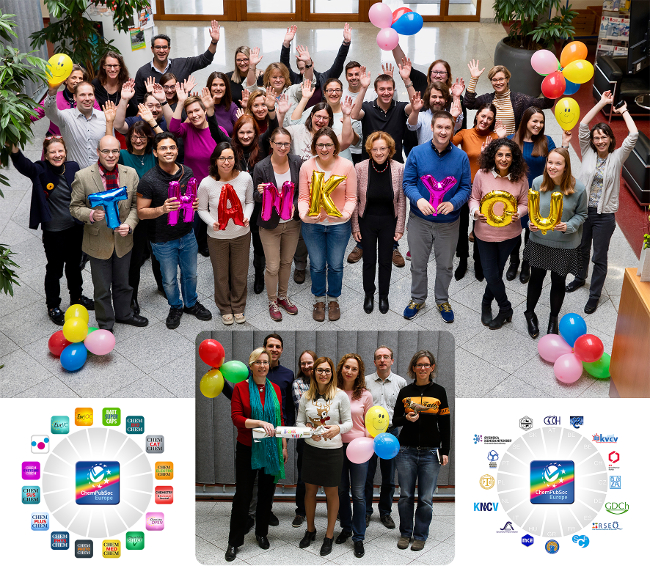 |
|
Caption: ChemPubSoc Europe colleagues assembled at the headquarters of the publishing house in Weinheim, Germany. Photo credit (2018): Mario Müller (top), Kim Meyer (bottom). |
Welcoming in the New Year
ChemPubSoc Europe’s in-house editors look forward to working with you in 2019, which promises to be a year packed with exciting projects. We’re motivated and energized—ready to celebrate the International Year of the Periodic Table of Chemical Elements (IYPT2019) with you. Read on for a sneak peak of what’s in the pipeline at each journal.
 Editor-in-Chief of Batteries & Supercaps, Dr. Greta Heydenrych, says: “In 2019, Batteries & Supercaps are planning several Special Issues on important topics in electrochemical energy storage, such as bifunctional catalysts for the oxygen evolution and reduction reactions (OER/ORR), interface engineering of electrode materials, and solid-state batteries. Your high-quality submissions are welcome!”
Editor-in-Chief of Batteries & Supercaps, Dr. Greta Heydenrych, says: “In 2019, Batteries & Supercaps are planning several Special Issues on important topics in electrochemical energy storage, such as bifunctional catalysts for the oxygen evolution and reduction reactions (OER/ORR), interface engineering of electrode materials, and solid-state batteries. Your high-quality submissions are welcome!”
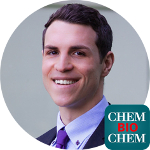 Managing Editor of ChemBioChem, Dr. Ruben Ragg, says: “ChemBioChem continues supporting early career researchers in 2019 with the ChemBioTalents Special Collection. We believe that the young researchers who contribute to this series will have a lasting impact in their respective research fields and we look forward to working with these gifted scientists in the future. In the New Year ChemBioChem will also publish a number of Special Issues. The Max Planck Research Network in Synthetic Biology (MaxSynBio) project forms the basis of one such Special Issue and this will be edited by four young group leaders. In January 2019, Issue 2 of ChemBioChem is devoted to carbohydrate chemistry pioneer, Prof. Chi-Huey Wong, on the occasion of his 70th birthday. And in February, a Special Issue on biosensing and bioimaging will be guest-edited by Assoc. Prof. Kanyi Pu (NTU).”
Managing Editor of ChemBioChem, Dr. Ruben Ragg, says: “ChemBioChem continues supporting early career researchers in 2019 with the ChemBioTalents Special Collection. We believe that the young researchers who contribute to this series will have a lasting impact in their respective research fields and we look forward to working with these gifted scientists in the future. In the New Year ChemBioChem will also publish a number of Special Issues. The Max Planck Research Network in Synthetic Biology (MaxSynBio) project forms the basis of one such Special Issue and this will be edited by four young group leaders. In January 2019, Issue 2 of ChemBioChem is devoted to carbohydrate chemistry pioneer, Prof. Chi-Huey Wong, on the occasion of his 70th birthday. And in February, a Special Issue on biosensing and bioimaging will be guest-edited by Assoc. Prof. Kanyi Pu (NTU).”
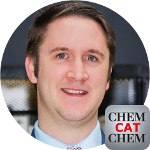 Editor-in-Chief of ChemCatChem, Michael Rowan, says: “ChemCatChem will celebrate its 10th anniversary in 2019. Owing to the excellent contributions of many people, we have produced a highly successful journal that serves all parts of a global catalysis community. In this spirit, we have partnered with the organizers of the International Symposium on the Relations between Homogeneous and Heterogeneous Catalysis (ISHHC 18) to create this anniversary issue.”
Editor-in-Chief of ChemCatChem, Michael Rowan, says: “ChemCatChem will celebrate its 10th anniversary in 2019. Owing to the excellent contributions of many people, we have produced a highly successful journal that serves all parts of a global catalysis community. In this spirit, we have partnered with the organizers of the International Symposium on the Relations between Homogeneous and Heterogeneous Catalysis (ISHHC 18) to create this anniversary issue.”
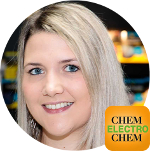 Editor-in-Chief of ChemElectroChem, Dr. Kate Lawrence, says: “ChemElectroChem kicks off the New Year with an Anniversary issue (01/2019) to celebrate its 5th birthday. Keep an eye on the journal’s webpage for a series of interesting Special Collections planned throughout the year. In 2019, ChemElectroChem will switch to a continuous publishing model, which means that authors will receive the page numbers for their accepted articles more rapidly than before. Identical transitions at other ChemPubSoc Europe journals have been very popular with authors.”
Editor-in-Chief of ChemElectroChem, Dr. Kate Lawrence, says: “ChemElectroChem kicks off the New Year with an Anniversary issue (01/2019) to celebrate its 5th birthday. Keep an eye on the journal’s webpage for a series of interesting Special Collections planned throughout the year. In 2019, ChemElectroChem will switch to a continuous publishing model, which means that authors will receive the page numbers for their accepted articles more rapidly than before. Identical transitions at other ChemPubSoc Europe journals have been very popular with authors.”
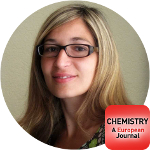 Senior Associate Editor of Chemistry—A European Journal, Francesca Novara, says: “In 2019, Chemistry—A European Journal will be a forum for everything chemists love about the elements. Dedicated content from authorities, such as the chemical philosopher Dr. Eric Scerri and theoretician Eugen Schwarz, will explore the periodic table from different angles. The journal will publish a series titled ‘In My Element’ in which board members talk about their relationship to particular elements, and authors will be invited to prepare periodic-table-inspired covers throughout the year. Running in parallel is a Facebook competition for unusual pictures on the theme of the periodic table and keep an eye on our Twitter account for element-related Spotify tunes selected by our editors.”
Senior Associate Editor of Chemistry—A European Journal, Francesca Novara, says: “In 2019, Chemistry—A European Journal will be a forum for everything chemists love about the elements. Dedicated content from authorities, such as the chemical philosopher Dr. Eric Scerri and theoretician Eugen Schwarz, will explore the periodic table from different angles. The journal will publish a series titled ‘In My Element’ in which board members talk about their relationship to particular elements, and authors will be invited to prepare periodic-table-inspired covers throughout the year. Running in parallel is a Facebook competition for unusual pictures on the theme of the periodic table and keep an eye on our Twitter account for element-related Spotify tunes selected by our editors.”
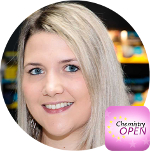 Editor-in-Chief of ChemistryOpen, Dr. Kate Lawrence, says: “ChemistryOpen continues to offer competitive pricing for open-access publishing. Furthermore, articles transferred from sister journals to ChemistryOpen may take advantage of a 20% discount upon acceptance. In 2019, readers can look forward to fantastic open-access content, including Special Collections on computational chemistry and biosynthesis.”
Editor-in-Chief of ChemistryOpen, Dr. Kate Lawrence, says: “ChemistryOpen continues to offer competitive pricing for open-access publishing. Furthermore, articles transferred from sister journals to ChemistryOpen may take advantage of a 20% discount upon acceptance. In 2019, readers can look forward to fantastic open-access content, including Special Collections on computational chemistry and biosynthesis.”
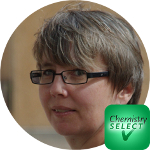 Editor-in-Chief of ChemistrySelect, Dr. Anne Deveson, says: “ChemistrySelect continues to offer the chemical research community a quality society-owned journal in which to publish work across all areas of chemistry. The journal recognizes that contemporary researchers are under considerable pressure to publish, and with this in mind, we are there to help you find a home for your work. At ChemistrySelect, articles accepted for publication are processed in an expedited production workflow to ensure rapid dissemination to the scientific community, and citation details are assigned upon online publication to allow immediate and accurate citing.”
Editor-in-Chief of ChemistrySelect, Dr. Anne Deveson, says: “ChemistrySelect continues to offer the chemical research community a quality society-owned journal in which to publish work across all areas of chemistry. The journal recognizes that contemporary researchers are under considerable pressure to publish, and with this in mind, we are there to help you find a home for your work. At ChemistrySelect, articles accepted for publication are processed in an expedited production workflow to ensure rapid dissemination to the scientific community, and citation details are assigned upon online publication to allow immediate and accurate citing.”
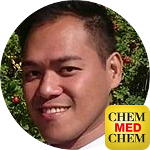 Editor-in-Chief of ChemMedChem, Dr. David Peralta, says: “ChemMedChem welcomes Prof. Sangyong Jon (KAIST) as its new editorial board co-chairperson in 2019. We thank departing Chairperson Rainer Metternich, now rejoining the International Advisory Board, for his valued services since the journal’s launch. In the New Year the journal will enlarge its scope to include biologics, including antibody–drug conjugates, and protein and macromolecular therapeutics. A number of Special Issues and Collections will cover topics such as neglected tropical diseases, epigenetics, neuromedicine, and medicinal chemistry in India. The latter will be published in conjunction with the 7th International Symposium on Current Trends in Drug Discovery Research (CTDDR 2019) in Lucknow, India.”
Editor-in-Chief of ChemMedChem, Dr. David Peralta, says: “ChemMedChem welcomes Prof. Sangyong Jon (KAIST) as its new editorial board co-chairperson in 2019. We thank departing Chairperson Rainer Metternich, now rejoining the International Advisory Board, for his valued services since the journal’s launch. In the New Year the journal will enlarge its scope to include biologics, including antibody–drug conjugates, and protein and macromolecular therapeutics. A number of Special Issues and Collections will cover topics such as neglected tropical diseases, epigenetics, neuromedicine, and medicinal chemistry in India. The latter will be published in conjunction with the 7th International Symposium on Current Trends in Drug Discovery Research (CTDDR 2019) in Lucknow, India.”
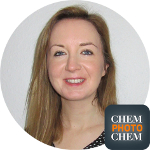 Associate Editor of ChemPhotoChem, Dr. Deanne Nolan, says: “‘Meet the Editorial Board’ is an interesting new initiative that will be launched by ChemPhotoChem in 2019 and will also be run at our sister journals ChemPhysChem, ChemSystemsChem, ChemElectroChem, and ChemistryOpen. In issues throughout the year, these journals will regularly feature opinion-style articles by Editorial Board Members and Chairs. Each article will describe the board member’s research focus and the current state-of-the-art within their given field, and the critical issues that must be addressed in order for the topic to break new ground will also feature. We are confident that these series will prove an invaluable resource, particularly to early career researchers, and will serve to highlight the latest developments in important chemistry topics related to the journal’s scope. Each contribution will be compiled in a special collection on the journal homepage and we also plan to promote each piece on social media. The first article, by one of the ChemPhotoChem Editorial Board Chairs, Axel Griesbeck, is now online.”
Associate Editor of ChemPhotoChem, Dr. Deanne Nolan, says: “‘Meet the Editorial Board’ is an interesting new initiative that will be launched by ChemPhotoChem in 2019 and will also be run at our sister journals ChemPhysChem, ChemSystemsChem, ChemElectroChem, and ChemistryOpen. In issues throughout the year, these journals will regularly feature opinion-style articles by Editorial Board Members and Chairs. Each article will describe the board member’s research focus and the current state-of-the-art within their given field, and the critical issues that must be addressed in order for the topic to break new ground will also feature. We are confident that these series will prove an invaluable resource, particularly to early career researchers, and will serve to highlight the latest developments in important chemistry topics related to the journal’s scope. Each contribution will be compiled in a special collection on the journal homepage and we also plan to promote each piece on social media. The first article, by one of the ChemPhotoChem Editorial Board Chairs, Axel Griesbeck, is now online.”
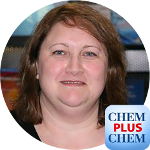 Editor-in-Chief of ChemPlusChem, Dr. Marisa Spiniello, says: “In 2019, ChemPlusChem looks forward to publishing the official Special Issue of the 18th International Symposium on Novel Aromatic Compounds (ISNA-18), hosted in Sapporo, Japan. This exciting event covers a wide range of subjects linked to the chemical property of aromaticity, and its expression in supramolecular chemistry, advanced materials, and optoelectronics, among others. A Special Collection relating to this event is already running and may be accessed here.”
Editor-in-Chief of ChemPlusChem, Dr. Marisa Spiniello, says: “In 2019, ChemPlusChem looks forward to publishing the official Special Issue of the 18th International Symposium on Novel Aromatic Compounds (ISNA-18), hosted in Sapporo, Japan. This exciting event covers a wide range of subjects linked to the chemical property of aromaticity, and its expression in supramolecular chemistry, advanced materials, and optoelectronics, among others. A Special Collection relating to this event is already running and may be accessed here.”
 Editor-in-Chief of ChemSusChem, Dr. David Smith, says: “In 2019, ChemSusChem continues a proud tradition of publication at the interface of chemistry and sustainability. Initiatives in the pipeline include a Spring Issue on the theoretical and practical aspects of water splitting and a Summer Issue on sustainable organic synthesis. Early in the year, a Special Issue will mark the 50th Anniversary of the Jerzy Haber Institute of Catalysis and Surface Chemistry in Poland. Operated by the Polish Academy of Sciences, this institute specializes in catalysis and the physical chemistry of phenomena occurring at interfaces.”
Editor-in-Chief of ChemSusChem, Dr. David Smith, says: “In 2019, ChemSusChem continues a proud tradition of publication at the interface of chemistry and sustainability. Initiatives in the pipeline include a Spring Issue on the theoretical and practical aspects of water splitting and a Summer Issue on sustainable organic synthesis. Early in the year, a Special Issue will mark the 50th Anniversary of the Jerzy Haber Institute of Catalysis and Surface Chemistry in Poland. Operated by the Polish Academy of Sciences, this institute specializes in catalysis and the physical chemistry of phenomena occurring at interfaces.”
 Editor-in-Chief of ChemistryViews.org and ChemViews Magazine, Dr. Vera Köster, says: “ChemistryViews.org will highlight the IYPT2019 in the New Year, including all the activities of ChemPubSoc Europe journals and its owner societies to mark the occasion. Remember to enter our Element Video Competition for the chance to win an iPad.”
Editor-in-Chief of ChemistryViews.org and ChemViews Magazine, Dr. Vera Köster, says: “ChemistryViews.org will highlight the IYPT2019 in the New Year, including all the activities of ChemPubSoc Europe journals and its owner societies to mark the occasion. Remember to enter our Element Video Competition for the chance to win an iPad.”
 Associate Editor of the European Journal of Inorganic Chemistry (EurJIC), Dr. Elliot Steeples, says: “In 2019, EurJIC continues its proud support of the Inorganic Chemistry Division of the Italian Chemical Society with a Special Collection of Microreviews highlighting the work of Nasini medalists. Other initiatives on the horizon include four Special Issues covering a diverse range of topics: polyoxometalates, neutron scattering in coordination chemistry, phosphorus, and artificial photosynthesis. In its ongoing institute feature initiative, in collaboration with EurJOC, EurJIC highlights fascinating inorganic chemistry research taking place at research institutes globally. Contact the EurJIC editorial office to discuss a Special Collection for your institute.”
Associate Editor of the European Journal of Inorganic Chemistry (EurJIC), Dr. Elliot Steeples, says: “In 2019, EurJIC continues its proud support of the Inorganic Chemistry Division of the Italian Chemical Society with a Special Collection of Microreviews highlighting the work of Nasini medalists. Other initiatives on the horizon include four Special Issues covering a diverse range of topics: polyoxometalates, neutron scattering in coordination chemistry, phosphorus, and artificial photosynthesis. In its ongoing institute feature initiative, in collaboration with EurJOC, EurJIC highlights fascinating inorganic chemistry research taking place at research institutes globally. Contact the EurJIC editorial office to discuss a Special Collection for your institute.”
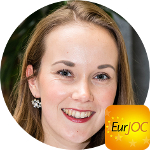 Associate Editor of the European Journal of Organic Chemistry (EurJOC), Dr. Charlotte Gers-Panther, says: “Following on from three successful European Institute Features this year (ICIQ, LIKAT, and IOCB), EurJOC will publish an issue devoted to the Zelinsky Institute of Organic Chemistry in Russia, in Summer of 2019. If you would like to see the organic chemistry research at your institute featured, contact the EurJOC editorial office. In 2019, EurJOC is also planning a series of Special Issues on organic reaction mechanisms, 50 years of Rotaxanes (Guest Editor, Jean-Pierre Sauvage), and the 27th International Society of Heterocyclic Chemistry (ISHC) Congress in Kyoto. The latter will be a collaborative effort with the Asian Journal of Organic Chemistry (AsianJOC).”
Associate Editor of the European Journal of Organic Chemistry (EurJOC), Dr. Charlotte Gers-Panther, says: “Following on from three successful European Institute Features this year (ICIQ, LIKAT, and IOCB), EurJOC will publish an issue devoted to the Zelinsky Institute of Organic Chemistry in Russia, in Summer of 2019. If you would like to see the organic chemistry research at your institute featured, contact the EurJOC editorial office. In 2019, EurJOC is also planning a series of Special Issues on organic reaction mechanisms, 50 years of Rotaxanes (Guest Editor, Jean-Pierre Sauvage), and the 27th International Society of Heterocyclic Chemistry (ISHC) Congress in Kyoto. The latter will be a collaborative effort with the Asian Journal of Organic Chemistry (AsianJOC).”
Join us for these activities, and more, in 2019! And remember, to enjoy the benefits of ChemPubSoc Europe membership simply join one of the 16 European chemical owner societies.
-> back to ChemPubSoc Europe Newsletter